| Srl | Item |
| 1 |
ID:
035312
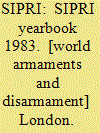

|
|
|
|
|
| Publication |
London, Taylor and Francis Ltd., 1983.
|
| Description |
lvi, 681p.hbk
|
| Series |
SIPRI Yearbook 1983
|
| Standard Number |
0850662478
|
|
|
|
|
|
|
|
|
|
|
|
Copies: C:1/I:0,R:0,Q:0
Circulation
| Accession# | Call# | Current Location | Status | Policy | Location |
| 021686 | 327.17405/SIP 021686 | Main | On Shelf | General | |
|
|
|
|
| 2 |
ID:
036296
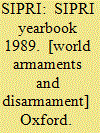

|
|
|
|
|
| Publication |
Oxford, Oxford University Press, 1989.
|
| Description |
xxi, 538p.hbk
|
| Series |
SIPRI Yearbook 1989
|
| Standard Number |
0198277512
|
|
|
|
|
|
|
|
|
|
|
|
Copies: C:1/I:0,R:0,Q:0
Circulation
| Accession# | Call# | Current Location | Status | Policy | Location |
| 030900 | 327.17405/SIP 030900 | Main | On Shelf | General | |
|
|
|
|
| 3 |
ID:
103493
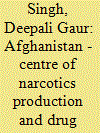

|
|
|
| 4 |
ID:
087411
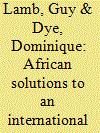

|
|
|
|
|
| Publication |
2009.
|
| Summary/Abstract |
Between 1998 and 2002, Africa was the region with the highest number of major armed conflicts compared on average eight distinct major armed conflicts each year during this five year period. These conflicts brew in the eastern region of the Democratic Republic of Congo, the Darfur region of Sudan and Somalia. The existence of armed non-state groups in the Central African Republic, Chad, Nigeria, as well as the high levels of firearms crime and violence in urban centers in Kenya and South Africa remains a critical humna security concern.
|
|
|
|
|
|
|
|
|
|
|
|
|
|
|
|
| 5 |
ID:
145695
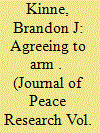

|
|
|
|
|
| Summary/Abstract |
This article assesses the impact of a new form of defense cooperation – formal weapons cooperation agreements, or WCAs – on the global arms trade. WCAs are bilateral framework agreements that establish comprehensive guidelines on the development, production, and exchange of conventional arms. Substantively, WCAs regulate such core areas as procurement and contracting, defense-based research and development, and defense industrial cooperation. These agreements have proliferated dramatically since the mid-1990s. They now number nearly 700, with 30–40 new WCAs signed each year. Newly collected data are used to analyze the effect of WCAs on import and export of conventional weapons. To control for interdependencies in the formation of WCAs, and to account for the mutually endogenous relationship between WCAs and weapons flows, WCAs are modeled as an interdependent network that coevolves with the individual-level arms trade activity of states. The analysis shows that, over the 1995–2010 period, WCAs have significantly increased weapons flows.
|
|
|
|
|
|
|
|
|
|
|
|
|
|
|
|
| 6 |
ID:
025672
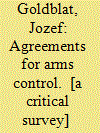

|
|
|
|
|
| Publication |
London, Taylar and Francis, 1982.
|
| Description |
xv, 387p.
|
| Standard Number |
085066229X
|
|
|
|
|
|
|
|
|
|
|
|
Copies: C:1/I:0,R:0,Q:0
Circulation
| Accession# | Call# | Current Location | Status | Policy | Location |
| 020093 | 327.174/SIP 020093 | Main | On Shelf | General | |
|
|
|
|
| 7 |
ID:
003079
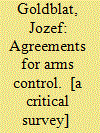

|
|
|
|
|
| Publication |
London, Taylor and Francis, 1982.
|
| Description |
xvi, 387p.
|
| Standard Number |
085066229X
|
|
|
|
|
|
|
|
|
|
|
|
Copies: C:1/I:0,R:0,Q:0
Circulation
| Accession# | Call# | Current Location | Status | Policy | Location |
| 034728 | 327.174/GOL 034728 | Main | On Shelf | General | |
|
|
|
|
| 8 |
ID:
007461
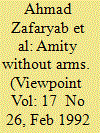

|
|
|
|
|
| Publication |
Feb 1992.
|
| Description |
23-30
|
|
|
|
|
|
|
|
|
|
|
|
|
|
|
|
| 9 |
ID:
013604
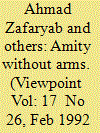

|
|
|
|
|
| Publication |
Feb 1992.
|
| Description |
23-30
|
|
|
|
|
|
|
|
|
|
|
|
|
|
|
|
| 10 |
ID:
083766
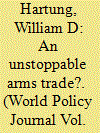

|
|
|
| 11 |
ID:
002549


|
|
|
|
|
| Publication |
Cambridge, Cambridge University Press, 1992.
|
| Description |
xviii, 299p.,figures,tables
|
| Series |
Cambridge studies in international relations; 22
|
| Standard Number |
0521394465
|
|
|
|
|
|
|
|
|
|
|
|
Copies: C:1/I:0,R:0,Q:0
Circulation
| Accession# | Call# | Current Location | Status | Policy | Location |
| 033877 | 338.47623/KRA 033877 | Main | On Shelf | General | |
|
|
|
|
| 12 |
ID:
143471
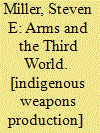

|
|
|
|
|
| Publication |
Geneva, Strategic and International Security Studies, 1980.
|
| Description |
62p.pbk
|
| Series |
PSIS Occasional Papers; no, 3
|
|
|
|
|
|
|
|
|
|
|
|
Copies: C:1/I:0,R:0,Q:0
Circulation
| Accession# | Call# | Current Location | Status | Policy | Location |
| 021486 | 355.0335/MIL 021486 | Main | On Shelf | General | |
|
|
|
|
| 13 |
ID:
045971
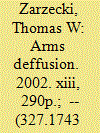

|
|
|
|
|
| Publication |
New York, Routledge, 2002.
|
| Description |
xiii, 290p.
|
| Standard Number |
0415935148
|
|
|
|
|
|
|
|
|
|
|
|
Copies: C:1/I:0,R:0,Q:0
Circulation
| Accession# | Call# | Current Location | Status | Policy | Location |
| 046974 | 327.1743/ZAR 046974 | Main | On Shelf | General | |
|
|
|
|
| 14 |
ID:
017984
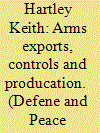

|
|
|
|
|
| Publication |
2000.
|
| Description |
443-548
|
|
|
|
|
|
|
|
|
|
|
|
|
|
|
|
| 15 |
ID:
112222
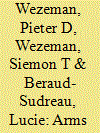

|
|
|
|
|
| Publication |
Sweden, SIPRI, 2011.
|
| Description |
vii, 49p.
|
| Series |
SIPRI Policy Paper No.30
|
| Standard Number |
9789185114696
|
|
|
|
|
|
|
|
|
|
|
|
Copies: C:1/I:0,R:0,Q:0
Circulation
| Accession# | Call# | Current Location | Status | Policy | Location |
| 056467 | 327.1740966/WEZ 056467 | Main | On Shelf | General | |
|
|
|
|
| 16 |
ID:
190704
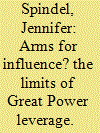

|
|
|
|
|
| Summary/Abstract |
Scholars and policymakers agree that major powers have leverage over their more junior partners. Giving security assistance or providing arms is supposed to increase this leverage. However, major powers often hit roadblocks when trying to influence the behaviour of their junior partners. This article demonstrates that junior partners are often successful in constraining the behaviour of the major power partners, and have particular success in extracting additional resources from their major partners. This article develops the concept of loyalty coercion to explain that leverage is based on rhetorical and symbolic moves, rather than material preponderance. It then uses cases of US arms sales to show that weapons transfers did not lead to US leverage, instead opened opportunities for junior partner influence. The article contributes to scholarly and policy perspectives on alliance management and reputation, and leverage in world politics.
|
|
|
|
|
|
|
|
|
|
|
|
|
|
|
|
| 17 |
ID:
055069
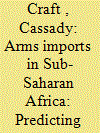

|
|
|
| 18 |
ID:
070614
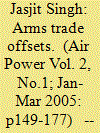

|
|
|
| 19 |
ID:
097189
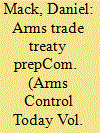

|
|
|
| 20 |
ID:
078233


|
|
|
|
|
| Publication |
2007.
|
| Summary/Abstract |
There is a large literature on the relationship between economic growth and defense spending, but its findings are often contradictory and inconclusive. These results may be partly due to non-linear growth effects of military expenditure and incorrect model specifications. The literature also appears lacking an empirical analysis of interaction between military spending and the arms trade and the impact of these two on growth. This paper investigates this non-linear interaction in the context of the Solow and Barro growth models recommended by Dunne et al.1 (2005). Using fixed effects, random effects, and Arellano-Bond GMM estimators, I examine the growth effects of military expenditure, arms trade, and their interaction in a balanced panel of 28 countries during 1965-2000. The augmented Solow growth model specified in Dunne et al. (2005) yields more robust estimates than the reformulated Barro model. I find that higher military spending and net arms exports separately lead to lower economic growth, but higher military spending is less detrimental to growth when a country is a net arms exporter.
|
|
|
|
|
|
|
|
|
|
|
|
|
|
|
|